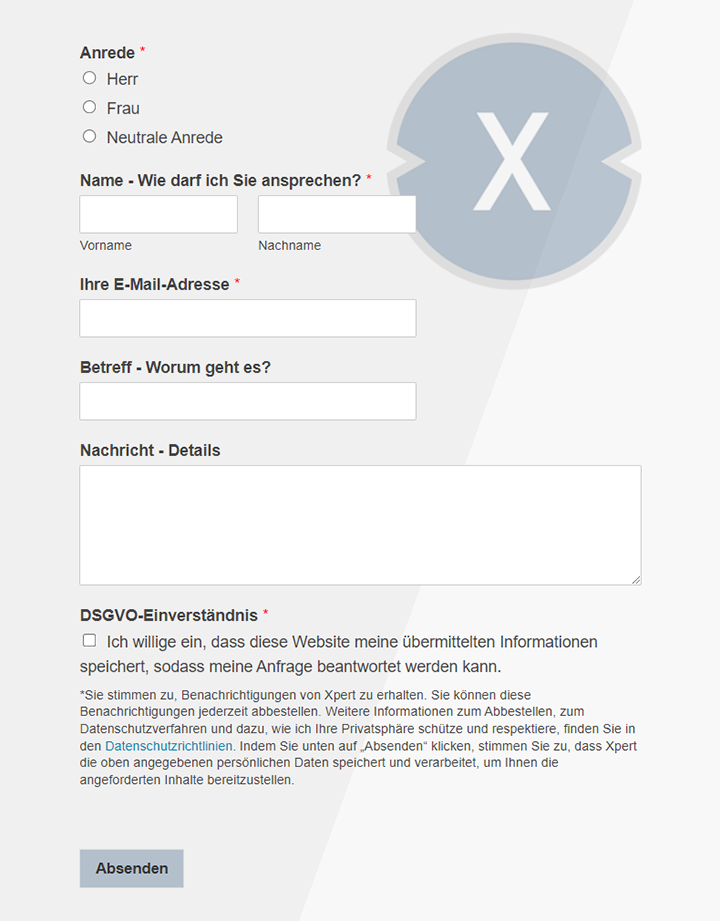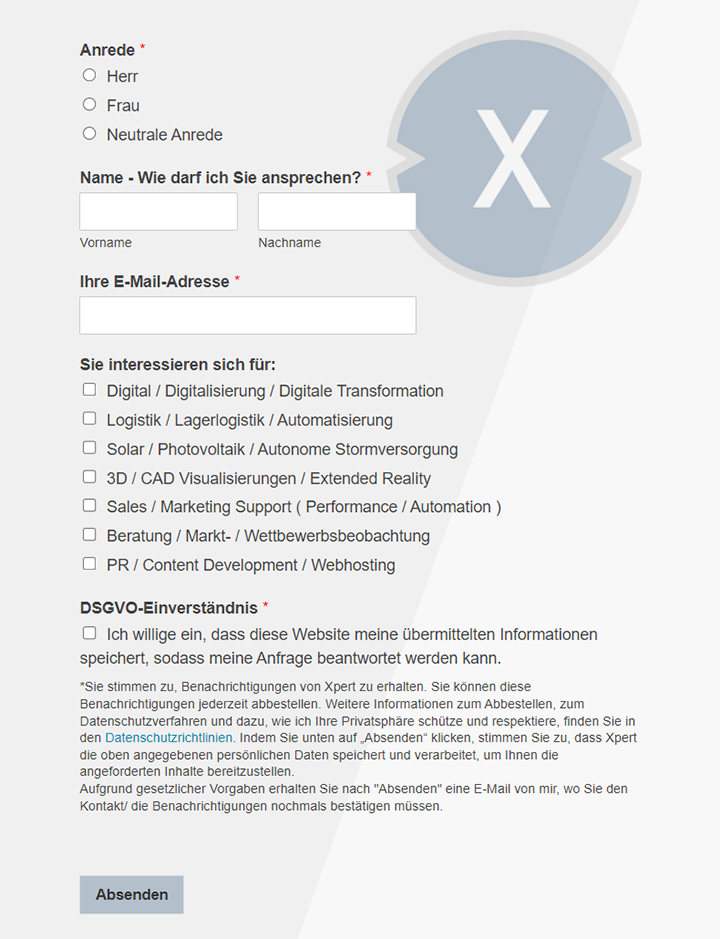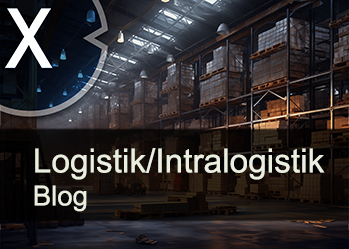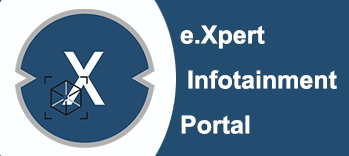GS1 Datamatrix: Logistics turbo for the military-less downtime thanks to optimized maintenance logistics
Xpert pre-release
Language selection 📢
Published on: April 22, 2025 / update from: April 29, 2025 - Author: Konrad Wolfenstein

GS1 Datamatrix: Logistics Turbo for the military-less downtime thanks to optimized maintenance logistics-Image: Xpert.digital
Telemaintenance: improvement, acceleration and flexibility of defense logistics with the GS1 Datamatrix (reading time: 35 min / no advertising / no paywall)
Smart maintenance in the military: GS1 Datamatrix optimizes the logistics of the military
Modern defense logistics faces the challenge of keeping complex weapons systems ready for use in globally distributed and potentially endangered areas of application. Telemaintenance (remote maintenance) has proven to be a decisive factor in increasing operational readiness by enabling the remote diagnosis and support by experts. The GS1 Datamatrix, a standardized 2D barcode with high data capacity and fault tolerance, offers a robust method for the clear identification of components and to link digital data. The integration of the GS1 Datamatrix in Telemainttenance processes significantly improves the data quality, accelerates diagnosis and repair processes and increases the surgical flexibility of maintenance. Despite challenges such as data security and system interior operability, the advantages through improved logistical intelligence, reduced downtime and potentially lower costs outweigh. This report analyzes the synergies between Telemainttenance and GS1 Datamatrix, examines application examples, challenges and future trends and gives recommendations for implementing this powerful combination in defense logistics.
Suitable for:
- Safety-relevant components in mechanical engineering: Schaeffler rolling bearings with digital twin and GS1 DataMatix for optimized maintenance and reliability
The strategic need for advanced defense logistics and maintenance
The complexity of modern military equipment increases steadily, while operations are increasingly being distributed and potentially competitive environments. This places enormous requirements for defense logistics and maintenance. Efficient logistics and maintenance are inextricably linked to the operational readiness, the enforcement capacity (“lethality”) and the operational pace of the armed forces. At the same time, shrinking defense budgets force efficiency increases in all areas. The ability to wait and repair equipment quickly and reliably, often under difficult conditions, is a strategic advantage.
Telemainttenance: a key factor for global operational capacity and willingness
In response to the logistical hurdles of traditional maintenance methods - such as limited access to defective device, long transport routes for spare parts or the need for highly specialized personnel on site - telemaintance is established. It acts as a “Combat Multiplier”, which improves the support for inherently used units and increases operational readiness. In essence, telemaintenance enables the use of specialist expertise and technology from a distance in order to carry out maintenance tasks without the expert having to be physically present.
Modernization of maintenance: GS1 Datamatrix in defense logistics
Automatic identification and data acquisition (AIDC) or Automatic Identification Technology (AIT) are basic technologies for modern logistics. They enable the quick and error -free recording of data about objects in the logistical process. The GS1 Datamatrix is a specific, powerful 2D barcode standard within this technology family. Its robustness, high data capacity and compactness have led to its adaptation in demanding sectors such as defense, aerospace and healthcare. GS1 standards in general create a “common language” for the supply chain, which promotes interoperability and efficiency.
Optimized defense logistics: Synergies by GS1 Datamatrix and Telemainttenance
The aim of this article is to comprehensively analyze the synergetic potential of the integration of the GS1 DataMatrix standard in telemaintenance processes within defense logistics. It is examined how this combination can contribute to improvement, acceleration and flexibility of maintenance logistics. The report is divided as follows: First of all, telemainness is defined in the context of defense logistics. The GS1 Datamatrix standard is then explained in detail. This is followed by the integration of the code into telemaintenance processes. The specific advantages are examined in terms of improvement, acceleration and flexibility. Application examples from defense and related industries are presented, followed by a discussion of potential challenges. A comparison with traditional methods and a view of future trends complete the analysis.
Telemaintenance in the context of defense logistics
Definition and functional principles
Telemaintenance, also referred to as remote maintenance or remote diagnosis, is defined as the implementation of maintenance tasks on equipment from a distance using telecommunications and digital technologies. It is primarily a communication tool that enables technicians to exchange information about equipment, visual data (e.g. live images), to exchange errors and in some cases even to transfer software updates remote to solve problems in real time. The core concept is to enable diagnosis, troubleshooting and repair instructions by experts without having to be physically on site. You can imagine it as a “remote repair for tanks and fighter planes”.
This ability to support remote support is not monolithic, but encompasses a spectrum of possibilities. It ranges from simple telephone consultations and the exchange of messages for diagnostic support to complex, data-intensive remote diagnoses, including real-time system data, video transmissions and detailed, gradual instructions for repairs, possibly even using remote-controlled tools. The methods and technologies used are adapted to the complexity of the problem, the type of equipment and the available infrastructure at the scene. This adaptability makes telemaint dance a flexible tool for various maintenance scenarios.
Enabling technologies and infrastructure
Successful implementation of telemaintenance requires a robust technological basis. This includes in particular:
- High-speed telecommunications networks: Reliable and high-band-wide connections are essential for the transmission of data, language and video in real time.
- Safe data transfer protocols: Protecting sensitive technical and operational data is of the utmost importance. Safe telephony and news channels as used by the US Army are examples of this. Encryption and authentication are essential.
- Video conference systems: They enable the visual inspection of devices and direct communication between the technician on site and the remote expert.
- Remote diagnostic tools: software and hardware that enable system parameters and error codes to read and analyze from a distance.
- (Optional) Remote controlled robotics: for inspections or manipulations in dangerous or inaccessible areas.
- Digital maintenance tools: mobile end devices, specialized measuring devices and software, which are used by the local staff and the remote experts.
A seamless integration of these telemaintenance systems into existing maintenance information systems (maintenance information system-MIS) or general automated information systems (AIS) The armed forces is crucial for efficiency and continuous documentation.
Operative scenarios in defense
Telematenance is used in various military scenarios:
- Support from distant or isolated units: particularly valuable in extensive areas of application such as desert regions or in peace safety operations with limited resources and staff.
- Maintenance of complex special equipment: For systems such as medical devices (e.g. computer tomograph, laboratory or lung diagnostic devices), for which only a few specialists are available, remote expertise can be decisive. Often only central depots or specialized units such as the Medical Maintenance Operations Divisions (MMods) of the Usamma have the necessary depth knowledge.
- Reduction of downtimes of critical systems: If the rapid restoration of the operational readiness of key technologies is a priority, Telemainttenance can significantly speed up the repair process. One example is a CT scanner that may be the only available device on a large radius.
- Multioclicism of knowledge: Telemaintenance enables the expert knowledge of experienced technicians in rear areas or central depots (sustainment levels) to be passed on directly to the technicians in the field (e.g. 68a biomedical equipment specialists) and to guide them in complex tasks.
The GS1 Datamatrix standard explained
Technical specifications and structure
The GS1 Datamatrix is a two-dimensional (2D) matrix barcode, which is printed as a square or rectangular symbol from individual dark and light modules (often realized as points or squares). Its structure consists of several key elements:
- Finder patterns (search pattern): A striking “L” pattern made of continuous lines on two striking pages (mostly left and bottom). This pattern serves the reader for localization, alignment and recognition of the symbol size and possible distortions.
- Timing patterns (clock pattern / “clock track”): A pattern of alternating dark and bright modules on the two opposite edges of the Finder pattern. It defines the basic structure (raster size) of the symbol and also helps with size and distortion detection.
- Data area: The matrix of dark and bright modules within the patterns that encode the actual information.
- Error correction (Error Correction Code-ECC): The GS1 Datamatrix uses the ECC 200 standard based on the Reed Solomon algorithm. This enables high fault tolerance; The symbol can often be read even even if parts of it are damaged or illegible (up to 20-30% or even 50% damage are mentioned in sources).
- High data density: It can save a large amount of information on a very small area - up to 2,335 alphanumeric or 3.116 numerical characters in the largest square variants. Even for pure product identification (GTIN), the space requirement can be below 5 x 5 mm.
- Quiet zone (rest zone): A mandatory bright area around the entire symbol, which must be free of disturbing graphic elements in order not to affect reading.
Data coding with GS1 Application Identifiers (AIS)
A decisive feature that distinguishes the GS1 Datamatrix from a generic data matrix is the use of a specific data structure according to the GS1 standards. This is signaled by the special functional mark FNC1, which is on the first code word position in the data field. This sign informs the scanner that the following data is structured in accordance with the GS1 syntax.
GS1 Application Identifier (AIS) is used within this structure. AIS are two- or multi-digit numerical prefixes that define the importance, the format and the (solid or variable) length of the immediately following data field. They enable the unambiguous interpretation of the coded data through any system that the GS1 standards know.
Relevant AIS for defense logistics and maintenance include, for example:
- (01) Global Trade Item Number (GTin) - Productural
- (10) Batch/Lot Number - batch number
- (17) Expiration Date - expiry date
- (21) Serial Number - serial number
- (00) Serial Shipping Container Code (SSCC) - Identification of logistics units
- (414) Global Location Number (GLN) - Identification of locations/parties
- (8003) Global Returnable Asset Identifier (GRAI) - Identification of reusable assets (e.g. container)
- (8004) Global Individual Asset Identifier (Giia) - Identification of individual assets
- (7001) NATO Stock Number (NSN)-specific AI for the NATO supply number
- (241) NATO Commercial and Government Entity (Ncage) Code / Part Number
Several AI data field pairs can be concentrated (chained) in a single GS1 Datamatrix symbol to encodes comprehensive information. In the case of data fields with variable length, the FNC1 sign is also used as a separator to signal the end of a field and the beginning of the next AIS if this is not implied by predefined maximum length.
This standardization is fundamental. While a generic data matrix is only a accumulation of data that has to be interpreted proprietary, the GS1 Datamatrix provides a clearly defined structure through the FNC1 detection and the AIS. For example, a system recognizes that after the AI (21) the serial number always follows and the batch number after (10). This enables the seamless data exchange and the interoperability between different logistical and technical systems in the entire defense ecosystem - from production to storage and transport to maintenance in the field and in the depot. This cross-system comprehensibility is the basis for efficient, scalable and data-controlled telemaintness operations.
Relevance for logistics and maintenance data
The technical properties of the GS1 Datamatrix make it particularly suitable for the requirements of modern defense logistics and maintenance:
- Comprehensive data coding: The high data capacity allows you to bundle all relevant identification and attribute data (part number, serial number, batch, manufacturer, date, etc.) in a single symbol.
- Direct partial marking (Direct Part Marking - DPM): Due to its small size and the possibility of applying it directly by means of las estimate or needle embossing, the code can also be permanently marked on small individual components, where labels would be impractical or non -durable.
- Robust and readability: The high fault tolerance by ECC 200 ensures reliable readability even under rough operating conditions (pollution, abrasion, damage).
- Standardization and interoperability: The use of the GS1 structure with AIS ensures that the encoded data of various systems and organizations (e.g. within the DOD, NATO, between manufacturers and armed forces, potentially also between allies) can be interpreted clearly and consistently.
Suitable for:
- GS1 DataMatrix Code Data diversity in a small space: Why Direct Part Marking (DPM) is becoming the new standard
Integration of the GS1 Datamatrix into the telemaint dance of the defense
The role of AIDC when linking physical assets and digital data
Automatic identification technologies (AIDC/AIT) such as barcodes and RFID form the decisive bridge between physical objects (equipment, components, spare parts) and their digital representations or “digital twins” in information systems. The scanning of the GS1 Datamatrix on a component serves as a trigger and primary data input for the Telemainttenance workflow. It provides the unique identifier of the asset and potentially further encoded attributes (such as batch or serial number).
Process integration: From scanning to the remote action
The integration of the GS1 Datamatrix into the Telemainttenance process can be ideally described in the following steps:
- Step 1: Identification: A technician in the field determines a malfunction on a component. Using a suitable 2D image (hand scanner, robust mobile device, integrated scanner integrated in tools), he scans the GS1 Datamatrix code, which is attached to the part (e.g. via label or DPM).
- Step 2: Data transmission: The data read from the code, structured by GS1 AIS (e.g. Giia (8004), serial number (21), Charge (10)), are transferred to the central telemaintness platform or directly to the system of the supportive expert via a secured network (e.g. encrypted WLAN, satellite connection).
- Step 3: Information calls: The receiving system uses the unique identifier (e.g. the Giiia or the combination of manufacturer/part number and serial number) to automatically access all relevant information from connected databases. This typically includes the complete maintenance history, the current configuration of the part, technical manuals, circuit diagrams, specific diagnostic procedures, possibly real-time sensor data (if the asset is networked) and known problems or modifications for this special batch or series.
- Step 4: Remote diagnosis: The remote expert is clearly shown the information collected. Supplemented by live video transmission, audio communication and, if necessary, other data shared by the field technician (e.g. measurement results), the expert analyzes the situation and diagnoses the cause of the error.
- Step 5: Considered action: Based on the diagnosis, the expert gradually leads the technician on site through the necessary test and repair measures. This can be done through verbal instructions, the display of markings or instructions in the video image or even by remote control of diagnostic tools. Required spare parts, which are also identified by scan on your GS1 Datamatrix, can be requested directly.
- Step 6: Documentation: All spare parts used (identified by your unique IDS) and the final status of the asset are automatically or partially automatically documented in the central maintenance system (e.g. dpas or another AIS) with reference to the clear ID of the edited assets.
This process integration makes the GS1 Datamatrix more than just a static label. It becomes an active key that triggers an automated and rich flow of information. Instead of the fact that the technician has to describe the part cumbersome or must read and transmit a number manually, the system immediately knows which exact component it is, what history it has and which technical data is relevant. This information is immediately available to the remote expert, which reduces the need for manual research and enables it to concentrate directly on the problem solving. This reduces the cognitive stress on both sides, minimizes errors through false identification and significantly standardizes the beginning of each telemaintenance process.
Data flow architecture and system requirements
Such integration places specific requirements for IT infrastructure and system architecture:
- Reading devices: 2D barcode scanners or Imager are required that can read GS1 Datamatrix and ideally suitable for the robust field use. Mobile end devices (tablets, smartphones) with integrated cameras and corresponding software can also be used.
- Network connectivity: A secure and reliable network connection (wired or wireless, possibly via satellite) between the site and the support center is essential.
- Database systems: A central or fed database infrastructure must be available in order to be able to save asset information (master data, history, configuration) and to be able to access the GS1 identifiers (Giia, GTin+Serial, etc.). Integration with existing DOD logistics and maintenance systems (AIS), such as the defense logistics management standards (DLMS), is critical.
- Telemainttenance platform: A software platform is required that offers functions for data display, secure real-time communication (video, audio, chat, whiteboarding/annotation) and potentially remote control of tools.
- GS1 Parsing ability: The software must be able to correctly interpret the data structure of a scanned GS1 Datamatrix, i.e. recognize the AIS and extract and process the associated data fields.
Relevant GS1 identifiers and Application Identifier (AIS) for telemaintenance in defense

Relevant GS1 identifiers and application Identifier (AIS) for telemaintenance in defense-Image: Xpert.digital
GS1 identifiers and application identifiers (AIS) play a central role in the defense in order to clearly identify assets and ensure their traceability. The relevant keys include the Global Individual Asset Identifier (Giia), which clearly characterizes specific, individual assets such as vehicles, weapons or components. This is often coded under AI (8004) and is recognized by both DOD and NATO. The Global Returnable Asset Identifier (GRAI), which characterizes reusable assets such as containers or pallets, is also important and is encoded under AI (8003). The Global Trade Item Number (GTin), coded under AI (01), serves the clear identification of product types, in particular spare parts. For logistics, the serial shipping container code (SSCC) is crucial under AI (00), because it marks logistics units such as pallets or boxes. The global location number (GLN), encodes under AI (414), identifies physical locations such as depots or workshops as well as legal entities such as manufacturers or units.
With the Application Identifies, the GTIN under AI (01) offers a uniform labeling of commercial items, while Batch/Lot Number is used under AI (10) for batch or lot numbers, which is essential for traceability and configuration management. The expiry date is coded under AI (17) and is specifically relevant for materials with a limited lifespan. Serial numbers of individual instances of a product type are awarded by AI (21). The SSCC under AI (00) serves to identify logistics units, while the grass identifies specific assets under AI (8004) under AI (8003). The NATO Stock Number (NSN) is coded under AI (7001) and promotes interoperability with NATO systems. Finally, the AI (241) supports the specification of customer-specific part numbers as well as NATO Cage numbers and their combinations.
🎯📊 Integration of an independent and cross-data source-wide AI platform 🤖🌐 for all company matters

Integration of an independent and cross-data source-wide AI platform for all company matters-Image: Xpert.digital
Ki-Gamechanger: The most flexible AI platform-tailor-made solutions that reduce costs, improve their decisions and increase efficiency
Independent AI platform: Integrates all relevant company data sources
- This AI platform interacts with all specific data sources
- From SAP, Microsoft, Jira, Confluence, Salesforce, Zoom, Dropbox and many other data management systems
- Fast AI integration: tailor-made AI solutions for companies in hours or days instead of months
- Flexible infrastructure: cloud-based or hosting in your own data center (Germany, Europe, free choice of location)
- Highest data security: Use in law firms is the safe evidence
- Use across a wide variety of company data sources
- Choice of your own or various AI models (DE, EU, USA, CN)
Challenges that our AI platform solves
- A lack of accuracy of conventional AI solutions
- Data protection and secure management of sensitive data
- High costs and complexity of individual AI development
- Lack of qualified AI
- Integration of AI into existing IT systems
More about it here:
Recoverability newly thought: advantages of GS1 Datamatrix in maintenance
Analysis of the advantages
The integration of GS1 Datamatrix in Telemainttenance processes offers significant advantages that can be summarized in the categories of improvement, acceleration and flexibility.
Improvement (improvement): data quality, traceability and maintenance intelligence
The integration of the GS1 Datamatrix in Telemainttenance processes leads to a significant improvement:
- Increased data quality and accuracy: The ECC 200 error correction mechanism of the GS1 Datamatrix minimizes reading errors even with damaged or dirty codes. Compared to manual data input, in which error rates can occur from 1 to 300-500 attacks, scanning of barcodes reduces errors drastically (error rates up to 1 to 10.5 million scans are mentioned). This ensures the correct identification of components, which is the basis for any further action.
- More precise maintenance information: By linking each maintenance action directly to the clear ID of the scanned asset (e.g. Giia or serial number), a precise and complete maintenance history for each individual is created. The co-entry of batches/lot numbers (AI 10) supports configuration management and enables the targeted tracking of problems that could affect specific production runs.
- Lifelong traceability (traceability): Especially through Direct Part Marking (DPM), the code remains permanently connected to the component, which enables continuous tracking from manufacturing to the separation (“Cradle-to-grave”). This is essential for the management of complex systems, the analysis of failure patterns and ensuring material authenticity.
- Effect reduction in the process: The automation of identification eliminates errors when entering part numbers, serial numbers, etc. This reduces the risk of working on the wrong component, applying incorrect procedures or using inappropriate spare parts. Experiences from the healthcare system, where GS1 Datamatrix demonstrably reduces medication errors by over 50%, indicate analogous safety gains in the technical maintenance area.
Acceleration (acceleration): tightening of identification, diagnosis and repair
The integration of the GS1 Datamatrix in Telemainttenance processes leads to significant acceleration:
- Faster component identification: Scanning a 2D code is significantly faster than reading and entering information or searching in catalogs. Omnidirectional readability (regardless of the orientation of the code) additionally accelerates the scanning process.
- Faster access to data: The scan triggers the immediate access of relevant data - maintenance history, technical documentation, circuit diagrams, diagnostic outins - which are directly linked to the clear ID. Time -consuming manual searches for the right documents.
- Accelerated diagnosis: Since remote experts immediately receive the correct identification and the associated history, you can start with the actual error diagnosis without delay. The time for the initial information collection is minimized.
- Reduced downtimes (downtime): The sum of the acceleration effects - faster identification, faster data access, faster diagnosis - leads directly to shorter repair times and thus to a reduction in the downtimes of critical equipment. This increases the availability and operational readiness.
Flexibility (flexibility): enabling remote support and adaptive maintenance
The integration of the GS1 Datamatrix in Telemainttenance processes leads to significant flexibility:
- Remote diagnosis and support independent of location: Expert knowledge can be provided regardless of the geographical location of the defective device. This is crucial for distant, isolated or dangerous locations where specialists are not or are difficult to available.
- Required maintenance (CBM+/predictive maintenance): The GS1 Datamatrix delivers the clear asset ID that is needed to correctly assign sensor data, usage data or diagnostic reports to a specific component. This is a basic requirement for condition-based (condition-based maintenance-CBM+) or forward-looking maintenance strategies (predictive maintenance). A scan could, for example, trigger specific test froutes or initiate the transmission of current state data.
- Adaptability to locations: The need to physically send highly specialized repair teams to every location is reduced. Uniform quality of support can be guaranteed across different areas of application as long as there is a communication connection.
- Potential for extended information access (GS1 Digital Link): In the future, the GS1 Digital Link, coded in the Datamatrix, could be used in order to provide access to a variety of online resources (interactive manuals, video instructions, direct connection to support channels, real-time data feeds), which is far above the data stored in the code itself go out.
The combination of standardized, clear identification by the GS1 Datamatrix and the ability to remove and support and support and support telemaint dance thus decouples the maintenance expertise from the physical place of the needs. Traditionally, the expert, the defective part and the required tools had to come together in the same place. Telematenance takes up the need for the physical presence of the expert. The GS1 Datamatrix ensures that the remote expert knows exactly which physical part he has to do, which enables effective remote diagnosis and instructions. This decoupling creates a more agile, more reactionable and data -controlled maintenance organization. It enables flexibility in the dislocation of personnel and resources and supports advanced maintenance concepts such as CBM+by ensuring the reliable linking of data streams with specific assets. This can potentially reduce the logistical footprint for maintenance, since fewer specialists and extensive spare parts warehouse are required at front locations and instead it is used to use centralized expertise and fast data access.
Suitable for:
- Important information for logistics: Sunrise 2027, the Data Matrix code (2D barcode) or QR code will replace the barcode
Application examples and case studies
Although comprehensive, publicly documented case studies on the specific combination of GS1 Datamatrix and Telematenance in the defense sector are still rare, numerous examples show the successful application of the individual components and related technologies in defense and adjacent industries.
Implements in the defense area
- Us Army Medical Materiel Agency (Usamma): The example of the remote maintenance of CT scanners in Iraq and Kuwait by MMOMMOD-TRACY impressively shows how Telemainttenance channels (telephone, messaging) are used to diagnose complex medical devices, to dispose spare parts and to derive local technicians during repair and calibration. This led to a significant shortening of repair times by several weeks and saves considerable travel expenses. Even if the source does not explicitly mentioned the use of GS1 Datamatrix in this case, it demonstrates the telemaintness frame in which the code would be integrated as an identification means.
- Dod Item Unique Identification (IUID) Program: The Mil-StD-130N guideline of the US Department of Defense stipulates the clear labeling of relevant equipment using a unique item (UII), which is coded in a data matrix ECC 200 symbol. The structure of this UII often follows the GS1 principles (e.g. using the Giiia or grai or a combination of manufacturer identification [Cage code] and serial number) and uses GS1-compliant syntax. These IUID markings form the necessary basis in order to clearly identify assets by scan in logistics and maintenance processes, including telemaintenance.
- NATO UID and logistics standards: NATO also promotes the clear identification of material by Stanag 2290 (UID) and references GS1 as a possible “Issuing Agency” as well as GS1 identifiers such as Giai and Grai. Other NATO standards such as Stanag 4329 (Barcode Symbology) and Stanag 4281 (Marking for Shipment and Storage) are based on or use GS1 standards, including specific application Identifier for NSN (AI 7001) and Ncage/Part Number (AI 241), as well as SSCC and GLN. This underlines the endeavor to interoperability between the alliance partners based on common standards.
- Defense Logistics Agency (DLA): As a central logistics agency of the DOD, the DLA manages the global supply chain and uses AIT (barcodes, RFID) to improve transparency and efficiency. The DLA relies on the Defense Logistics Management Standards (DLMS) that explicitly provide EDI and AIT for data exchange and integrate commercial standards such as ANSI ASC X12 (on which GS1 EDI is based) and AIT technologies such as IUID and RFID. The use of GS1 standards by the DLA, for example in deliveries to NEXCOM using GS1-128 labels with SSCC, shows the anchoring of these standards in core processes of military logistics.
Findings from aerospace as well as healthcare
- Aerospace: This industry uses GS1 Datamatrix (in addition to other codes such as code 39/128) intensively for the permanent labeling of components (Direct Part Marking- DPM) according to standards such as ATA SPEC 2000 or AS9132. The markings are used for traceability over the entire life cycle, quality control and the support of maintenance and repair processes (MRO) for highly complex and security-critical components. Experience with DPM techniques on different materials and under extreme environmental conditions can be transferred directly to military applications.
- Healthcare (pharmaceuticals & medical technology): Here is the use of GS1 Datamatrix for the serialization of medication and the clear labeling of medical devices (Unique Device Identification - Udi) through regulatory requirements (e.g. FDA UDI and DSCSA in the USA, FMD, similar regulations in over 75 countries) widespread. This industry has gained extensive experience in the high-speed identification and verification of codes with dynamic data (GTIN, batch, expiry date, serial number) on primary and secondary packaging as well as partly directly on products (e.g. surgical instruments). The knowledge gained in terms of print quality, scanner technology, data management architectures and integration in supply chains and clinical systems are of high value for defense logistics.
The width, often regulatory use of the GS1 Datamatrix in these highly permissible and security -critical sectors provides a strong validation of its technical suitability for demanding environments. It shows that a large -scale implementation is challenging, but is feasible and associated with significant advantages in relation to traceability, efficiency and security - advantages that are directly transferable to the goals of military maintenance and telematenance. Defense organizations therefore do not have to reinvent solutions, but can use proven approaches and technologies from these industries and adapt them, which potentially reduces implementation risks and costs.
Challenges in implementation and reduction strategies
Despite the convincing advantages, the introduction of a GS1 DataMatrix-based telemaintness solution in the defense environment is associated with specific challenges that must be addressed proactively.
Cyber security and data protection
Challenge: The transmission of sensitive technical data (configurations, weaknesses, maintenance history) via networks carries risks. End points such as scanners and mobile devices in the field as well as the central systems must be protected against unauthorized access, manipulation and spying. The integrity of the maintenance databases is critical.
Intimitation strategy: Use of strong encryption for data transmission and storage, robust authentication mechanisms (e.g. multi -factor authentication), network segmentation, use of intrusion detection/prevention systems, strict compliance with the applicable military cybersecurity policies and standards, regular security reviews and penetration tests.
Interoperability and integration of old systems
Challenge: The integration of new AIDC hardware (2D scanner) and telemaintenance software platforms into the often heterogeneous and partially outdated IT landscape of the military (various AIS, partly still on Mils-based systems, specific maintenance databases such as DPAS) is complex. The guarantee of seamless and standard -compliant data exchange (e.g. via DLMS) between old and new systems is crucial.
Dimertion strategy: use of middleware, standardized interfaces (APIs) and data formats (GS1, DLMS/EDI); Prioritization of integration with systems that already offer modern interfaces; Gradually introduction (phased rollout); Definition of interoperability requirements as a core component in the procurement of new systems; Ensure that systems can correctly process the GS1 data structures.
Costs, infrastructure and training
Challenge: The introduction requires initial investments in hardware (2D scanner, possibly DPM equipment, robust end devices, servers), software licenses, potential network upgrades (especially for bandwidth and reliability in the field) and the development or adaptation of software. In addition, there is the costs for the training of the staff-technicians in the field, remote experts, IT administrators and logisticians.
Design strategy: implementation of detailed cost-benefit analyzes that quantify the return on investment through reduced downtime, avoided travel expenses and increased efficiency; Use of existing network infrastructure where possible; Development of comprehensive, role -specific training programs; Examination of commercial-off-the-shelf (Cots) or government-off-the-shelf (GOTS) solutions for cost reduction; If necessary, leasing models for hardware.
Robust and readability under operating conditions
Challenge: The readability of the Datamatrix codes must also be guaranteed under adverse conditions in the field (pollution from oil/dust, mechanical damage, poor lighting conditions, extreme temperatures). The scanners used must be correspondingly robust.
Dimertion strategy: Use of resistant DPM methods (las estimate, needle embossing) instead of labels for exposed or durable parts; Selection of high-quality materials and printing/marking processes for codes with maximum fault tolerance (ECC 200); Use of industrial or militarily specified scanners with advanced image processing technology; Determination and monitoring of clear quality standards for code marking (e.g. according to ISO/IEC 15415).
Standardization and governance
Challenge: The consistent application of the GS1 standards (correct AIS, data formats, syntax) via various sub-dispute, units, weapons systems and potentially also between alliance partners must be ensured. The administration of GS1 prefixes and the allocation of clear identifiers requires coordination. The coexistence of different barcodes on a product can lead to confusion and false scans.
Dimension strategy: Establishment of clearer, forward-looking guidelines and implementation guidelines (based on existing UID mandates); central or coordinated management of the GS1 identifiers; Establishment of a strong program governance structure; Promotion of standard conformity through training and audits; close coordination with NATO partners for harmonization; Strategies for reducing the number of barcodes per package/component (“one barcode” destination).
GS1 Datamatrix: Implementation challenges and reduction strategies
The implementation of the GS1 Datamatrix brings with it various challenges that require both strategic and technical measures in order to be mastered efficiently. In the area of cyber security and data protection, sensitive data must be protected in transmission and storage, and endpoints and systems must be secured. Strategies such as strong encryption, authentication, network segmentation, IDS/IPS and the compliance with DOD guidelines through regular audits are essential. Interoperability and old system integration represents another hurdle, especially when integrating new hardware and software into heterogeneous, partly outdated IT landscapes. Middleware, APIs, standard formats such as GS1 or DLMS as well as the prioritization of interoperability help with new procurement to ensure data exchange. Costs, infrastructure and necessary training must also be taken into account, since initial investments for scanners, DPM, networks and software as well as training effort for different roles are incurred. These costs can be made more efficient with ROI analyzes, the use of existing infrastructure, testing of Cots/GOTS and comprehensive training programs. Robust and readability is particularly important, so codes remain readable under rough conditions such as dirt, damage or unfavorable light. DPM methods such as laser or needle embossing, high-quality and robust codes with error correction (ECC 200), industrial scanners and quality standards such as ISO 15415 contribute to the solution. In order to ensure standardization and governance, a consistent application of GS1 standards (e.g. AIS and syntax) and the central administration of IDS is critical. Clear guidelines, centralized ID management, program governance, training programs and compliance with compliance requirements, coordinated with partners such as NATO, support this. A comprehensive "one barcode" strategy also brings clarity and efficiency.
The successful operational introduction of this technology therefore not only requires the procurement of technology, but above all careful planning, significant investments and a strong leadership in order to overcome the considerable hurdles in the areas of integration, security, costs and standardization that exist in the complex defense environment. A cross -departmental cooperation between logistics, IT, cyber defense and financial planning as well as a possibly classified procedure are likely to be decisive for success.
🎯🎯🎯 Benefit from Xpert.Digital's extensive, fivefold expertise in a comprehensive service package | R&D, XR, PR & SEM

AI & XR 3D Rendering Machine: Fivefold expertise from Xpert.Digital in a comprehensive service package, R&D XR, PR & SEM - Image: Xpert.Digital
Xpert.Digital has in-depth knowledge of various industries. This allows us to develop tailor-made strategies that are tailored precisely to the requirements and challenges of your specific market segment. By continually analyzing market trends and following industry developments, we can act with foresight and offer innovative solutions. Through the combination of experience and knowledge, we generate added value and give our customers a decisive competitive advantage.
More about it here:
From manual processes to machine precision: progress with GS1 Datamatrix
Comparative analysis: GS1 Datamatrix approach vs. Traditional methods
The approach of supporting telemainness by using GS1 Datamatrix represents a paradigm shift towards traditional maintenance practices.
Limitations of conventional practices
Traditional methods of maintenance and logistics persecution in defense often suffer from the following restrictions:
- Manual processes: strong dependence on manual data input and manual looking information, which is slow and prone to errors.
- Inconsistent labeling: often not standardized, difficult to read or ambiguous parts markings.
- Fragmented documentation: maintenance historia are often paper -based or stored in various, non -networked digital systems, which makes it difficult to access the full history.
- Physical presence required: The need that specialized technicians have to be physically on site leads to long waiting times, high travel expenses and logistical challenges, especially in remote or dangerous areas.
- A lack of real-time transparency: Often there is no current overview of the state of assets or the progress of maintenance work. Older systems like Mils only offered limited real -time capabilities.
- Reactive maintenance: maintenance decisions are often based on fixed intervals or only occur after a failure instead of based on the actual condition of the device.
Key differentiation features: speed, accuracy, data depth, flexibility
The GS1 Datamatrix-based telemaintness approach differs in essential points:
- Identification: Automated, almost immediate scanning replaces manual reading and searching.
- Accuracy: High accuracy through error correction codes and elimination of manual input errors compared to high susceptibility to human errors.
- Data access & depth: A single scan potentially provides a wealth of structured data (clear ID, batch, series, expiry date, etc.), while traditional labels often only contain limited information and require further manual research.
- Expertise: enables remote access to centralized experts, which reduces the dependence on the availability of local specialists.
- Process control: In contrast to often manual, reactive processes, enables data -controlled, potentially predictive maintenance processes.
- Traceability: offers the possibility of complete life cycle traceability, especially when using DPM, while this is often incomplete or very complex for traditional methods.
- Flexibility: high (adaptation in place, time, need), supports CBM+
- Speed: faster diagnosis & repair, reduced downtime
Comparison of GS1 Datamatrix/Telemainttenance vs. Traditional methods
The comparison between GS1 Datamatrix/Telemainttenance and traditional methods shows significant differences in different aspects. In the area of identification, GS1 Datamatrix offers automated, fast and clear detection by the GS1 standard, while traditional methods of manual, often slow and potentially ambiguous processes are shaped. With regard to the accuracy, GS1 Datamatrix scores through the use of error corrections and the waiver of manual entries, which significantly reduces the error rate. However, traditional methods are more susceptible to human reading errors and typing errors. The data depth and data access are also particularly high for GS1 Datamatrix due to the storage of extensive information in a code and the possibility of an immediate data retrieval, while conventional approaches are often limited to a few data points and require a manual search.
In the area of expertise, GS1 Datamatrix enables the resident of the resort to central experts that are independent of location, whereas traditional methods require the physical presence of specialists on site. Processes are driven and standardized by GS1 Datamatrix, with potential for proactive and predictive approaches. Traditional methods are more manually and reactive, mostly in response to failures or planned intervals. The traceability can be fully implemented with GS1 Datamatrix, especially when using the Direct Part Marking (DPM), which is often only possible to a limited extent in traditional methods and can be associated with great effort.
GS1 Datamatrix also impresses with the flexibility by adaptability on the spot, time and needs as well as with the support of condition-based maintenance plus (CBM+). In contrast, traditional methods depend heavily on the availability of staff on site. With regard to the speed, GS1 datamatrix enables faster diagnoses and repairs and thus contributes to reducing downtime, while conventional approaches are considerably slower through manual work steps, travel and time -consuming information searches. The costs for GS1 Datamatrix are initially higher, but offer long -term savings potential due to lower travel expenses and shorter downtimes. In contrast, traditional methods cause high costs due to travel, lengthy downtimes and inefficiencies.
This comparison makes it clear that the GS1 DataMatrix-based telemaintenance approach not only represents an incremental improvement, but also enables a fundamental transformation towards a more efficient, more precise and flexible maintenance paradigm. He addresses many of the inherent weaknesses of traditional methods. However, successful adaptation not only requires new tools, but potentially also significant adjustments to the work processes, the distribution of roles and the training of the staff.
Future prospects and technological trends
The combination of GS1 Datamatrix and Telemainttenance cannot be seen as an end point, but as an important building block for future developments in defense logistics and maintenance.
Synergy with artificial intelligence (AI), predictive analytics and digital twins
The GS1 Datamatrix delivers the reliable, unique identifier that is needed to link physical assets with their digital twins and the associated data streams (sensor data, operating data, environmental data). This solid data basis is the prerequisite for advanced analyzes within the framework of CBM+ and Predictive Maintenance. On the basis of these data, algorithms can recognize patterns, predict the future state of components and recommend proactive maintenance measures, which can then be triggered and guided by telemaintenance. AI can also support remote experts in the diagnosis by recognizing patterns in the transmitted data and generating hypotheses.
Evolution of data carriers and connectivity (GS1 Digital Link)
An important trend is the increasing ability to encounter not only identifiers and attributes, but also web addresses (URIS) in barcodes. The GS1 Digital Link Standard defines a syntax to translate GS1 identifiers into a web uri structure, which can then be encoded in a data carrier such as the Datamatrix (or QR code). A single scan could then lead the technician or experts directly to a dynamic range of online resources: interactive, context-sensitive manuals, diagnostic assistants, video tutorials, direct connection to live support channels or real-time dats-dashboards. This would revolutionize information access in the field. Integration with mobile devices (smartphones, tablets) and specialized apps for scanning and interaction with this data will continue to increase.
The development of logistical remote support in defense
Telematenance is expected to develop from a niche solution to a standard model of maintenance support, which potentially reduces the need for personnel and material at front locations (“less mechanics, more data streams”). Integration with autonomous systems such as drones or soil robots for the quick delivery of spare parts to the location or even for remote -controlled manipulations under guidance via telepresence is a promising future field. The exchange of logistical data and the cooperation between partial disputes, alliance partners and industry will be further intensified by the use of common standards such as GS1 in order to create a seamless, interoperable logistics chain. “Logistics Information” itself is increasingly recognized and used as a critical resource for operational decisions.
These trends indicate that GS1 Datamatrix and Telematenance are fundamental pioneers for a future vision of defense logistics, which acts highly automated, intelligent, networked and predictive. Strategic investments in these basic technologies are therefore crucial to ensure future operational readiness and to maintain a technological lead in logistics and maintenance.
Suitable for:
- New logistics solutions with AI agents and 2D matrix codes: The future of the industry with DataMatrix matrix logistics
Strategic lead: Optimization of defense logistics by GS1 Datamatrix
Minimize downtimes, maximize operational readiness: the synergy of GS1 Datamatrix and Telemainttenance
The integration of the GS1 DataMatrix standard in Telemainttenance processes offers considerable strategic added value for defense logistics. The core advantages lie in the significant improvement in data quality and accuracy, the seamless traceability of components, the acceleration of diagnosis and repair cycles, which leads to reduced downtime, and significantly increased flexibility in providing maintenance support. In the long term there is also potential for cost savings from reduced travel expenses and optimized resource use. Synergy is clear: The GS1 Datamatrix delivers the standardized, machine -readable key to the data of an asset, while telemaintance provides the communication channel in order to use this data and the expert knowledge derived from it effectively and independently. This combined approach is a critical factor for the modernization of defense logistics and ensuring operational readiness in complex and dynamic global surgical environments.
Key recommendations for introduction and optimization
In order to raise the full potential of this technology, the following strategic recommendations are derived:
- Development of a clear strategy and governance: A cross-departmental (DOD/NATO-wide) strategy and a clear set of rules for the implementation of GS1 DataMatrix-based telemaint dance should be developed. This should build on existing UID guidelines and define aspects such as standard conformity, data management and role distribution.
- Prioritized implementation: The introduction should initially be concentrated on high -quality, complex or particularly default -critical weapon systems and components, in which reduced downtimes bring the greatest operational benefit.
- Investation in infrastructure and equipment: It must be invested in a robust, safe and sufficiently powerful network infrastructure (also in the field) and in compatible AIDC equipment (robust 2D scanner, possibly DPM systems).
- Focus on interoperability: From the beginning, attention must be paid to the interoperability of the new systems with existing logistics and maintenance platforms. Compliance with standards such as DLMS and GS1 is essential. In the event of new procurement, interoperability requirements must be stipulated.
- Comprehensive training programs: Roll-specific training programs for all participating groups of people (field technicians, remote experts, logisticians, IT personnel) must be developed and carried out to ensure the acceptance and effective use of the new technologies.
- Proactive management of cyber security risks: cyber security must be an integral part of the entire system life cycle, from the conception to implementation to operation.
- Use of external expertise and cooperation: Cooperation with industrial partners and the exchange of “Lessons Learned” with sectors such as aerospace and healthcare that already have extensive experience with GS1 Datamatrix should be actively sought.
- Pilot projects for future technologies: The potential of new standards such as GS1 Digital Link To further improve information access should be evaluated as part of pilot projects.
The consistent implementation of these recommendations can help to master the challenges of implementation and to develop the transformative power of GS1 Datamatrix and telemaintenance for more powerful, more agile and more cost -efficient defense logistics.
glossary
- AIDC (automatic identification and data capture): automatic identification and data acquisition; Technologies for automatic recording data about objects (e.g. barcodes, RFID).
- AI (Application Identifier): GS1 application designer; Numerical code (2-4 digits) in GS1 barcodes, which defines the meaning and format of the following data.
- AIS (Automated Information System): Automated Information System; General term for IT systems to support business processes in DOD.
- AIT (automatic identification technology): Technology for automatic identification; Similar to AIDC.
- CBM+ (Condition-Based Maintenance Plus): Condition-based maintenance plus; Maintenance strategy based on the actual condition of the equipment supplemented by analyzes and logistics considerations.
- Cage Code (Commercial and Authority ID): Clear five-digit code to identify companies that do business with the US government.
- DLMS (Defense Logistics Management Standards): Standards of the US Department of Defense for Electronic Data Exchange (EDI) in logistics.
- Dod (Department of Defense): Ministry of Defense of the United States.
- DPM (Direct Part Marking): Direct parts marking; Permanent attachment of a code (e.g. data matrix) directly on the surface of a part (e.g. by las estimate, needle embossing).
- DPAS (Defense Property Accountability System): DOD system for managing and tracking property, including maintenance data.
- ECC 200 (Error Correction Code 200): Specific error correction standard for Data Matrix Barcodes, which is based on the Reed Solomon algorithm and offers high fault tolerance. Is used by GS1 Datamatrix.
- EDI (Electronic Data Interchange): Electronic data exchange; Standardized exchange of business documents in electronic form.
- FNC1 (Function Code 1): Special control sign in GS1 barcodes (including GS1 Datamatrix in the first place), which can signal compliance with the GS1 data structure and act as a separator.
- Giia (global individual asset identifier): global individual asset identifier; GS1 key for the clear identification of individual assets.
- Gln (global location number): global location number; GS1 key for the clear identification of physical locations or legal entities.
- Grai (global returning asset identifier): global reusable asset identifier; GS1 key for the clear identification of reusable transport or storage containers.
- GS1: Global standardization organization for supply chains (developed UA barcodes, identification numbers, EDI standards).
- GS1 Datamatrix: A specific implementation of the Data Matrix ECC 200 Barcodes that uses the GS1 data structure (with FNC1 and AIS).
- GS1 Digital Link: GS1 standard for coding GS1 identifiers in a web uri structure that enables access to online information via a barcode.
- Gtin (global trade item number): global article number; GS1 key for the clear identification of trade products (articles on a certain packaging level).
- Iuid (item unique identification): clear identification of objects; DOD program for the clear labeling of military property.
- MIL-STD-130: DOD military standard, which defines the requirements for iUID identification.
- Mils (Military Standard Logistics Systems): Older generation of DOD logistics systems, based on outdated technology.
- MMOD (Medical Maintenance Operations Division): Department of Usamma, which is responsible for the maintenance of medical devices.
- NATO (North Atlantic Treaty Organization): North Atlantic Pact organization.
- Ncage (NATO Commercial and Government Entity Code): NATO version of the Cage Codes.
- NSN (NATO Stock Number): 13-digit NATO supply number for the clear identification of material.
- RFID (radio frequency identification): radio frequency identification; Technology for automatic identification using radio waves.
- SSCC (Serial Shipping Container Code): Number of the shipping unit; GS1 key for the clear identification of logistics units (e.g. pallets, boxes).
- Stanag (Standardization Agreement): Standardization Convention of NATO.
- Telemaintenance: remote maintenance; Implementation of maintenance tasks (diagnosis, instructions for repair) from a distance using telecommunications technology.
- Udi (Unique Device Identification): Clear product identification for medical devices (often using GS1 Datamatrix).
- UII (unique item identifier): clear article identifier; The specific identifier that is assigned to a single article as part of the DOD IUID program.
- Usamma (US Army Medical Materiel Agency): Agency of the US Army for medical material.
Advice - planning - implementation
I would be happy to serve as your personal advisor.
Head of Business Development
Chairman SME Connect Defense Working Group
We are there for you - advice - planning - implementation - project management
☑️ SME support in strategy, consulting, planning and implementation
☑️ Creation or realignment of the digital strategy and digitalization
☑️ Expansion and optimization of international sales processes
☑️ Global & Digital B2B trading platforms
☑️ Pioneer Business Development
I would be happy to serve as your personal advisor.
You can contact me by filling out the contact form below or simply call me on +49 89 89 674 804 (Munich) .
I'm looking forward to our joint project.
Xpert.Digital - Konrad Wolfenstein
Xpert.Digital is a hub for industry with a focus on digitalization, mechanical engineering, logistics/intralogistics and photovoltaics.
With our 360° business development solution, we support well-known companies from new business to after sales.
Market intelligence, smarketing, marketing automation, content development, PR, mail campaigns, personalized social media and lead nurturing are part of our digital tools.
You can find out more at: www.xpert.digital - www.xpert.solar - www.xpert.plus


































